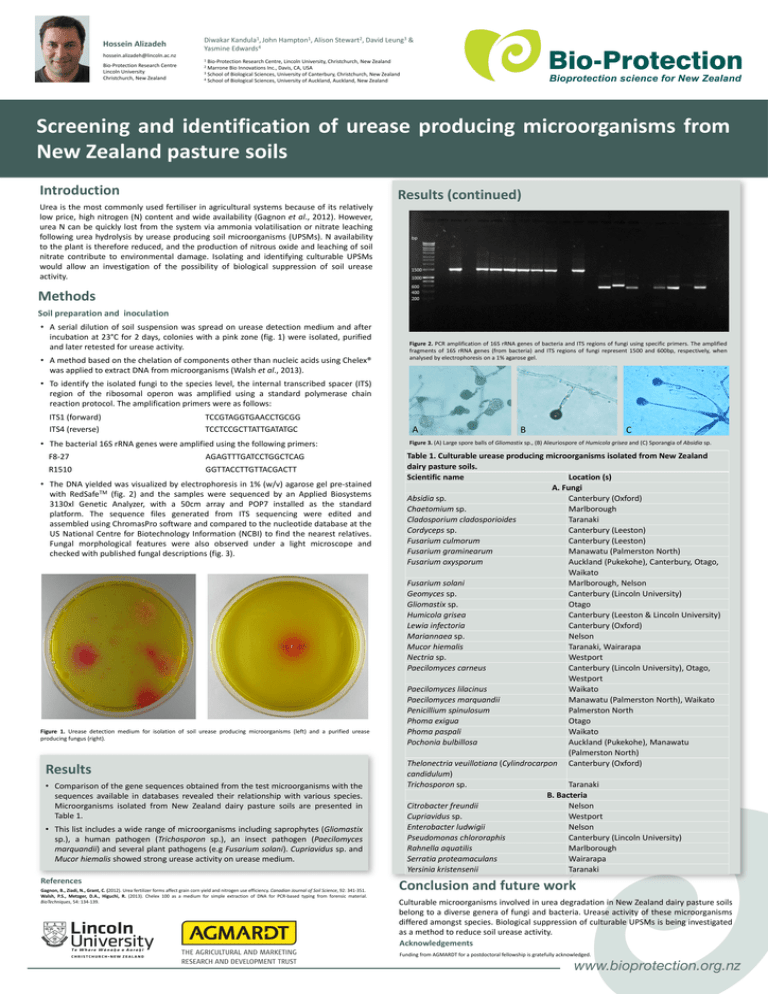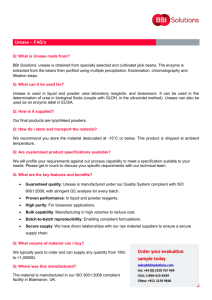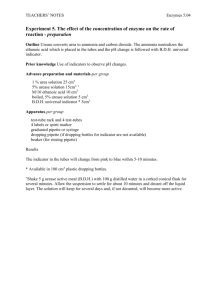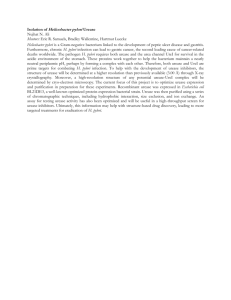Document 13513017
advertisement

Author photo Hossein Alizadeh Diwakar Kandula1, John Hampton1, Alison Stewart2, David Leung3 & Yasmine Edwards4 hossein.alizadeh@lincoln.ac.nz 1 Bio-Protection Research Centre Lincoln University Christchurch, New Zealand Bio-Protection Research Centre, Lincoln University, Christchurch, New Zealand 2 Marrone Bio Innovations Inc., Davis, CA, USA 3 School of Biological Sciences, University of Canterbury, Christchurch, New Zealand 4 School of Biological Sciences, University of Auckland, Auckland, New Zealand Screening and identification of urease producing microorganisms from New Zealand pasture soils Introduction Results (continued) Urea is the most commonly used fertiliser in agricultural systems because of its relatively low price, high nitrogen (N) content and wide availability (Gagnon et al., 2012). However, urea N can be quickly lost from the system via ammonia volatilisation or nitrate leaching following urea hydrolysis by urease producing soil microorganisms (UPSMs). N availability to the plant is therefore reduced, and the production of nitrous oxide and leaching of soil nitrate contribute to environmental damage. Isolating and identifying culturable UPSMs would allow an investigation of the possibility of biological suppression of soil urease activity. Methods Soil preparation and inoculation • A serial dilution of soil suspension was spread on urease detection medium and after incubation at 23°C for 2 days, colonies with a pink zone (fig. 1) were isolated, purified and later retested for urease activity. • A method based on the chelation of components other than nucleic acids using Chelex® was applied to extract DNA from microorganisms (Walsh et al., 2013). Figure 2. PCR amplification of 16S rRNA genes of bacteria and ITS regions of fungi using specific primers. The amplified fragments of 16S rRNA genes (from bacteria) and ITS regions of fungi represent 1500 and 600bp, respectively, when analysed by electrophoresis on a 1% agarose gel. • To identify the isolated fungi to the species level, the internal transcribed spacer (ITS) region of the ribosomal operon was amplified using a standard polymerase chain reaction protocol. The amplification primers were as follows: ITS1 (forward) ITS4 (reverse) TCCGTAGGTGAACCTGCGG TCCTCCGCTTATTGATATGC • The bacterial 16S rRNA genes were amplified using the following primers: F8-27 AGAGTTTGATCCTGGCTCAG R1510 GGTTACCTTGTTACGACTT • The DNA yielded was visualized by electrophoresis in 1% (w/v) agarose gel pre-stained with RedSafeTM (fig. 2) and the samples were sequenced by an Applied Biosystems 3130xl Genetic Analyzer, with a 50cm array and POP7 installed as the standard platform. The sequence files generated from ITS sequencing were edited and assembled using ChromasPro software and compared to the nucleotide database at the US National Centre for Biotechnology Information (NCBI) to find the nearest relatives. Fungal morphological features were also observed under a light microscope and checked with published fungal descriptions (fig. 3). Figure 1. Urease detection medium for isolation of soil urease producing microorganisms (left) and a purified urease producing fungus (right). Results • Comparison of the gene sequences obtained from the test microorganisms with the sequences available in databases revealed their relationship with various species. Microorganisms isolated from New Zealand dairy pasture soils are presented in Table 1. • This list includes a wide range of microorganisms including saprophytes (Gliomastix sp.), a human pathogen (Trichosporon sp.), an insect pathogen (Paecilomyces marquandii) and several plant pathogens (e.g Fusarium solani). Cupriavidus sp. and Mucor hiemalis showed strong urease activity on urease medium. References Gagnon, B., Ziadi, N., Grant, C. (2012). Urea fertilizer forms affect grain corn yield and nitrogen use efficiency. Canadian Journal of Soil Science, 92: 341-351. Walsh, P.S., Metzger, D.A., Higuchi, R. (2013). Chelex 100 as a medium for simple extraction of DNA for PCR-based typing from forensic material. BioTechniques, 54: 134-139. A B C Figure 3. (A) Large spore balls of Gliomastix sp., (B) Aleuriospore of Humicola grisea and (C) Sporangia of Absidia sp. Table 1. Culturable urease producing microorganisms isolated from New Zealand dairy pasture soils. Scientific name Location (s) A. Fungi Absidia sp. Canterbury (Oxford) Chaetomium sp. Marlborough Cladosporium cladosporioides Taranaki Cordyceps sp. Canterbury (Leeston) Fusarium culmorum Canterbury (Leeston) Fusarium graminearum Manawatu (Palmerston North) Fusarium oxysporum Auckland (Pukekohe), Canterbury, Otago, Waikato Fusarium solani Marlborough, Nelson Geomyces sp. Canterbury (Lincoln University) Gliomastix sp. Otago Humicola grisea Canterbury (Leeston & Lincoln University) Lewia infectoria Canterbury (Oxford) Mariannaea sp. Nelson Mucor hiemalis Taranaki, Wairarapa Nectria sp. Westport Paecilomyces carneus Canterbury (Lincoln University), Otago, Westport Paecilomyces lilacinus Waikato Paecilomyces marquandii Manawatu (Palmerston North), Waikato Penicillium spinulosum Palmerston North Phoma exigua Otago Phoma paspali Waikato Pochonia bulbillosa Auckland (Pukekohe), Manawatu (Palmerston North) Thelonectria veuillotiana (Cylindrocarpon Canterbury (Oxford) candidulum) Trichosporon sp. Taranaki B. Bacteria Citrobacter freundii Nelson Cupriavidus sp. Westport Enterobacter ludwigii Nelson Pseudomonas chlororaphis Canterbury (Lincoln University) Rahnella aquatilis Marlborough Serratia proteamaculans Wairarapa Yersinia kristensenii Taranaki Conclusion and future work Culturable microorganisms involved in urea degradation in New Zealand dairy pasture soils belong to a diverse genera of fungi and bacteria. Urease activity of these microorganisms differed amongst species. Biological suppression of culturable UPSMs is being investigated as a method to reduce soil urease activity. Acknowledgements Funding from AGMARDT for a postdoctoral fellowship is gratefully acknowledged.








